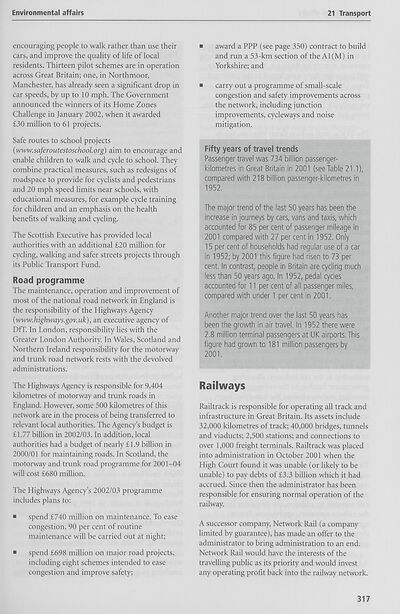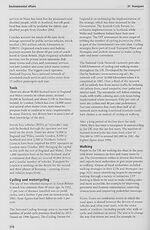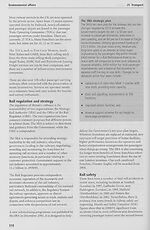Download files
Complete book:
Individual page:
Thumbnail gallery: Grid view | List view

Environmental affairs
21 Transport
encouraging people to walk rather than use their
cars, and improve the quality of life of local
residents. Thirteen pilot schemes are in operation
across Great Britain; one, in Northmoor,
Manchester, has already seen a significant drop in
car speeds, by up to 10 mph. The Government
announced the winners of its Home Zones
Challenge in January 2002, when it awarded
£30 million to 61 projects.
Safe routes to school projects
(www.saferoutestoschool.org) aim to encourage and
enable children to walk and cycle to school. They
combine practical measures, such as redesigns of
roadspace to provide for cyclists and pedestrians
and 20 mph speed limits near schools, with
educational measures, for example cycle training
for children and an emphasis on the health
benefits of walking and cycling.
The Scottish Executive has provided local
authorities with an additional £20 million for
cycling, walking and safer streets projects through
its Public Transport Fund.
Road programme
The maintenance, operation and improvement of
most of the national road network in England is
the responsibility of the Highways Agency
(www.highways.gov.uk), an executive agency of
DfT. In London, responsibility lies with the
Greater London Authority. In Wales, Scotland and
Northern Ireland responsibility for the motorway
and trunk road network rests with the devolved
administrations.
The Highways Agency is responsible for 9,404
kilometres of motorway and trunk roads in
England. However, some 500 kilometres of this
network are in the process of being transferred to
relevant local authorities. The Agency’s budget is
£1.77 billion in 2002/03. In addition, local
authorities had a budget of nearly £1.9 billion in
2000/01 for maintaining roads. In Scotland, the
motorway and trunk road programme for 2001-04
will cost £680 million.
The Highways Agency’s 2002/03 programme
includes plans to:
■ spend £740 million on maintenance. To ease
congestion, 90 per cent of routine
maintenance will be carried out at night;
■ spend £698 million on major road projects,
including eight schemes intended to ease
congestion and improve safety;
■ award a PPP (see page 350) contract to build
and run a 53-km section of the A1(M) in
Yorkshire; and
■ carry out a programme of small-scale
congestion and safety improvements across
the network, including junction
improvements, cycleways and noise
mitigation.
Fifty years of travel trends
Passenger travel was 734 billion passenger-
kilometres in Great Britain in 2001 (see Table 21.1),
compared with 218 billion passenger-kilometres in
1952.
The major trend of the last 50 years has been the
increase in journeys by cars, vans and taxis, which
accounted for 85 per cent of passenger mileage in
2001 compared with 27 per cent in 1952. Only
15 per cent of households had regular use of a car
in 1952; by 2001 this figure had risen to 73 per
cent. In contrast, people in Britain are cycling much
less than 50 years ago. In 1952, pedal cycles
accounted for 11 per cent of all passenger miles,
compared with under 1 per cent in 2001.
Another major trend over the last 50 years has
been the growth in air travel. In 1952 there were
2.8 million terminal passengers at UK airports. This
figure had grown to 181 million passengers by
2001.
Railways
Railtrack is responsible for operating all track and
infrastructure in Great Britain. Its assets include
32,000 kilometres of track; 40,000 bridges, tunnels
and viaducts; 2,500 stations; and connections to
over 1,000 freight terminals. Railtrack was placed
into administration in October 2001 when the
High Court found it was unable (or likely to be
unable) to pay debts of £3.3 billion which it had
accrued. Since then the administrator has been
responsible for ensuring normal operation of the
railway.
A successor company, Network Rail (a company
limited by guarantee), has made an offer to the
administrator to bring administration to an end.
Network Rail would have the interests of the
travelling public as its priority and would invest
any operating profit back into the railway network.
317
21 Transport
encouraging people to walk rather than use their
cars, and improve the quality of life of local
residents. Thirteen pilot schemes are in operation
across Great Britain; one, in Northmoor,
Manchester, has already seen a significant drop in
car speeds, by up to 10 mph. The Government
announced the winners of its Home Zones
Challenge in January 2002, when it awarded
£30 million to 61 projects.
Safe routes to school projects
(www.saferoutestoschool.org) aim to encourage and
enable children to walk and cycle to school. They
combine practical measures, such as redesigns of
roadspace to provide for cyclists and pedestrians
and 20 mph speed limits near schools, with
educational measures, for example cycle training
for children and an emphasis on the health
benefits of walking and cycling.
The Scottish Executive has provided local
authorities with an additional £20 million for
cycling, walking and safer streets projects through
its Public Transport Fund.
Road programme
The maintenance, operation and improvement of
most of the national road network in England is
the responsibility of the Highways Agency
(www.highways.gov.uk), an executive agency of
DfT. In London, responsibility lies with the
Greater London Authority. In Wales, Scotland and
Northern Ireland responsibility for the motorway
and trunk road network rests with the devolved
administrations.
The Highways Agency is responsible for 9,404
kilometres of motorway and trunk roads in
England. However, some 500 kilometres of this
network are in the process of being transferred to
relevant local authorities. The Agency’s budget is
£1.77 billion in 2002/03. In addition, local
authorities had a budget of nearly £1.9 billion in
2000/01 for maintaining roads. In Scotland, the
motorway and trunk road programme for 2001-04
will cost £680 million.
The Highways Agency’s 2002/03 programme
includes plans to:
■ spend £740 million on maintenance. To ease
congestion, 90 per cent of routine
maintenance will be carried out at night;
■ spend £698 million on major road projects,
including eight schemes intended to ease
congestion and improve safety;
■ award a PPP (see page 350) contract to build
and run a 53-km section of the A1(M) in
Yorkshire; and
■ carry out a programme of small-scale
congestion and safety improvements across
the network, including junction
improvements, cycleways and noise
mitigation.
Fifty years of travel trends
Passenger travel was 734 billion passenger-
kilometres in Great Britain in 2001 (see Table 21.1),
compared with 218 billion passenger-kilometres in
1952.
The major trend of the last 50 years has been the
increase in journeys by cars, vans and taxis, which
accounted for 85 per cent of passenger mileage in
2001 compared with 27 per cent in 1952. Only
15 per cent of households had regular use of a car
in 1952; by 2001 this figure had risen to 73 per
cent. In contrast, people in Britain are cycling much
less than 50 years ago. In 1952, pedal cycles
accounted for 11 per cent of all passenger miles,
compared with under 1 per cent in 2001.
Another major trend over the last 50 years has
been the growth in air travel. In 1952 there were
2.8 million terminal passengers at UK airports. This
figure had grown to 181 million passengers by
2001.
Railways
Railtrack is responsible for operating all track and
infrastructure in Great Britain. Its assets include
32,000 kilometres of track; 40,000 bridges, tunnels
and viaducts; 2,500 stations; and connections to
over 1,000 freight terminals. Railtrack was placed
into administration in October 2001 when the
High Court found it was unable (or likely to be
unable) to pay debts of £3.3 billion which it had
accrued. Since then the administrator has been
responsible for ensuring normal operation of the
railway.
A successor company, Network Rail (a company
limited by guarantee), has made an offer to the
administrator to bring administration to an end.
Network Rail would have the interests of the
travelling public as its priority and would invest
any operating profit back into the railway network.
317
Set display mode to:
![]() Universal Viewer |
Universal Viewer | ![]() Mirador |
Large image | Transcription
Mirador |
Large image | Transcription
The item on this page appears courtesy of Office for National Statistics and may be re-used under the Open Government Licence for Public Sector Information.
| Britain and UK handbooks > UK: The official yearbook of the United Kingdom of Great Britain and Northern Ireland > 2003 > (355) |
|---|
| Permanent URL | https://digital.nls.uk/204927725 |
|---|
| Attribution and copyright: |
|
|---|---|
| Description | Three volumes of 'UK: The official yearbook of the United Kingdom of Great Britain and Northern Ireland', published annually by the Office of National Statistics from 2002-2005. |
|---|---|
| Shelfmark | GII.11 SER |
| Description | Three titles produced by the British Government from 1954-2005 describing 'how Britain worked'. They are: 'Britain: An official handbook' (1954-1998), 'Britain: The official yearbook of the United Kingdom' (1999-2001), and 'UK: The official yearbook of the United Kingdom of Great Britain and Northern Ireland' (2002-2005). These 50 reports provide an overview of Britain's economic, social and cultural affairs, its environment, international relations, and the systems of government. They give an impartial summary of government policies and initiatives, and explain how public services are organised. |
|---|---|
| Additional NLS resources: |
|

